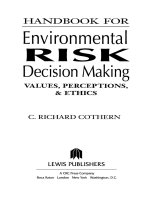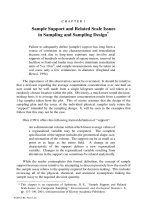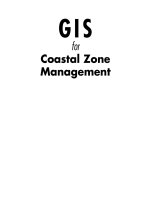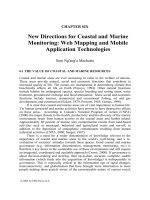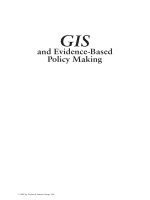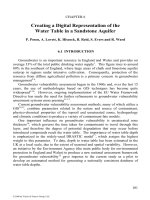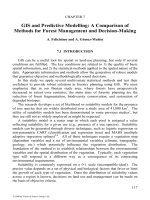GIS for Environmental Decision Making - Chapter 1 ppsx
Bạn đang xem bản rút gọn của tài liệu. Xem và tải ngay bản đầy đủ của tài liệu tại đây (727.27 KB, 28 trang )
GIS
for
Environmental
Decision-Making
© 2008 by Taylor & Francis Group, LLC
I N N O V A T I O N S I N G I S
SERIES EDITORS
Jane Drummond
University of Glasgow, Glasgow, Scotland
Bruce Gittings
University of Edinburgh, Edinburgh, Scotland
Elsa João
University of Strathclyde, Glasgow, Scotland
GIS for Environmental Decision-Making
Edited by Andrew Lovett and Katy Appleton
GIS and Evidence-Based Policy Making
Edited by Stephen Wise and Max Craglia
Dynamic and Mobile GIS: Investigating Changes in Space and Time
Edited by Jane Drummond, Roland Billen, Elsa João, and David Forrest
© 2008 by Taylor & Francis Group, LLC
Edited by
Andrew Lovett
Katy Appleton
I N N O V A T I O N S I N G I S
CRC Press is an imprint of the
Taylor & Francis Group, an informa business
Boca Raton London New York
GIS
for
Environmental
Decision-Making
© 2008 by Taylor & Francis Group, LLC
CRC Press
Taylor & Francis Group
6000 Broken Sound Parkway NW, Suite 300
Boca Raton, FL 33487‑2742
© 2008 by Taylor & Francis Group, LLC
CRC Press is an imprint of Taylor & Francis Group, an Informa business
No claim to original U.S. Government works
Printed in the United States of America on acid‑free paper
10 9 8 7 6 5 4 3 2 1
International Standard Book Number‑13: 978‑0‑8493‑7423‑4 (Hardcover)
This book contains information obtained from authentic and highly regarded sources. Reprinted material
is quoted with permission, and sources are indicated. A wide variety of references are listed. Reasonable
efforts have been made to publish reliable data and information, but the author and the publisher cannot
assume responsibility for the validity of all materials or for the consequences of their use.
Except as permitted under U.S. Copyright Law, no part of this book may be reprinted, reproduced, trans‑
mitted, or utilized in any form by any electronic, mechanical, or other means, now known or hereafter
invented, including photocopying, microfilming, and recording, or in any information storage or retrieval
system, without written permission from the publishers.
For permission to photocopy or use material electronically from this work, please access www.copyright.
com ( or contact the Copyright Clearance Center, Inc. (CCC) 222 Rosewood
Drive, Danvers, MA 01923, 978‑750‑8400. CCC is a not‑for‑profit organization that provides licenses and
registration for a variety of users. For organizations that have been granted a photocopy license by the
CCC, a separate system of payment has been arranged.
Trademark Notice: Product or corporate names may be trademarks or registered trademarks, and are
used only for identification and explanation without intent to infringe.
Library of Congress Cataloging‑in‑Publication Data
National Conference on GIS Research UK (12th : 2004 : Norwich, England)
GIS for environmental decision‑making / editors, Andrew Lovett and Katy
Appleton.
p. cm. ‑‑ (Innovation in GIS)
Papers from the GIS Research UK (GISRUK) 12th Annual Conference held at the
University of East Anglia, Norwich; April 28‑30, 2004.
Includes bibliographical references and index.
ISBN 978‑0‑8493‑7423‑4 (alk. paper)
1. Environmental policy‑‑Decision making‑‑Equipment and supplies‑‑Congresses.
2. Environmental sciences‑‑Information technology‑‑Congresses. 3. Geographic
information systems‑‑Congresses. 4. Environmental monitoring‑‑Data
processing‑‑Congresses. I. Lovett, Andrew A. II. Appleton, Katy, 1975‑ III. University
of East Anglia. IV. Title. V. Series.
GE170.N358 2008
628‑‑dc22 2007034392
Visit the Taylor & Francis Web site at
and the CRC Press Web site at
© 2008 by Taylor & Francis Group, LLC
v
Table of Contents
Preface
xi
List of Contributors
xiii
1 Developments in GIS for Environmental Decision-Making
A. Lovett and K. Appleton
1.1 Introduction 1
1.2 The role of GIS 1
1.3 The structure of the book 2
1.4 Where next? 5
1.5 References 6
Part I – Data for Decision-Making
9
2 An Optimized Semi-Automated Methodolo
gy
for Populatin
g
a National
Land-Use Dataset
W. Tompkinson, D. Morton, S. Gomm, and E. Seaman
2.1 Introduction 11
2.2 Data 11
2.3 Previous approaches to land-use classification 12
2.4 Ordnance Survey classification methodology 16
2.5 Accuracy assessment of SADDA and OSLUM 18
2.6 Conclusions 25
2.7 Acknowledgments 26
2.8 References 26
3 A New Framework for Feature-Based Digital Mapping in Three-
Dimensional Space
A. Slingsby, P. Longley, and C. Parker
3.1 Introduction 29
3.2 Case studies of existing frameworks 30
3.3 Design issues 39
3.4 Proposed model 47
3.5 Implementation 53
© 2008 by Taylor & Francis Group, LLC
vi GIS for environmental decision-making
3.6 Interim evaluation 54
3.7 Conclusion 55
3.8 Acknowledgments 56
3.9 References 56
4 From Electronic Logbooks to Sustainable Marine Environments: A
GIS to Support the Common Fisheries Policy
J. Whalley and Z. Kemp
4.1 Introduction
59
4.2 System design 64
4.3 Spatial decision support 66
4.4 Conclusions 72
4.5 Acknowledgments 73
4.6 References 73
Part II – Tools to Support Decision-Making
77
5 GIS and Environmental Decision-Makin
g
: From Sites to Strate
g
ies and
Back Again
R. MacFarlane and H. Dunsford
5.1 Introduction 79
5.2 Background: key themes 80
5.3 Case studies 83
5.4 Discussion 91
5.5 Conclusion: from local to strategic and back again 96
5.6 References 97
6 Creating a Digital Representation of the Water Table in a Sandstone
Aquifer
P. Posen, A. Lovett, K. Hiscock, B. Reid, S. Evers, and R. Ward
6.1 Introduction 101
6.2 Background 102
6.3 Methods 103
6.4 Results 107
6.5 Discussion of results 109
6.6 Conclusions 113
6.7 Acknowledgments 114
6.8 References 114
© 2008 by Taylor & Francis Group, LLC
Table of contents vii
7 GIS and Predictive Modelling: A Comparison of Methods for Forest
Management and Decision-Making
A. Felicísimo and A. Gómez-Muñoz
7.1 Introduction 117
7.2 Objectives 118
7.3 Study area 118
7.4 Data 120
7.5 Methods 121
7.6 Results 124
7.7 Concluding discussion 127
7.8 Acknowledgments 128
7.9 References 128
8 A Comparison of Two Techniques for Local Land-Use Change
Simulation in the Swiss Mountain Area
A. Walz, P. Bebi, and R. Purves
8.1 Introduction 131
8.2 Study area and data 133
8.3 Methodology 135
8.4 Results 141
8.5 Discussion 143
8.6 Conclusions 146
8.7 Acknowledgments 147
8.8 References 147
9 ‘Riding an Elephant to Catch a Grasshopper’: Applying and
Evaluating Techniques for Stakeholder Participation in Land-Use
Planning within the Kae Watershed, Northern Thailand
F. Shutidamrong and A. Lovett
9.1 Introduction 149
9.2 The case study 150
9.3 Research methodology 151
9.4 Comparing and refining land-use scenarios 156
9.5 Conclusions 161
9.6 Acknowledgments 162
9.7 References 162
10 Grid-Enabled GIS: Opportunities and Challenges
C. Jarvis
10.1 Introduction 165
10.2 Progress and challenges 170
10.3 Conclusions 175
© 2008 by Taylor & Francis Group, LLC
viii GIS for environmental decision-making
10.4 References 176
Part III – Participation in Decision-Making
179
11 Developments in Public Participation and Collaborative
Environmental Decision-Making
I. Bishop
11.1 Introduction 181
11.2 Separate development: GIS and visualization 183
11.3 Converging technologies: GIS-driven visualization 184
11.4 Integrated technologies: collaborative worlds 186
11.5 Conclusions 189
11.6 Acknowledgments 189
11.7 References 189
12 Using Virtual Reality to Simulate Coastal Erosion: A Participative
Decision Tool?
I. Brown, S. Jude, S. Koukoulas, R. Nicholls, M. Dickson, and M. Walkden
12.1 Introduction 193
12.2 Simulation and visualization concepts 194
12.3 Simulation modelling of coastal erosion 196
12.4 Interface with GIS 197
12.5 VR visualization 202
12.6 Discussion 204
12.7 Conclusions 207
12.8 Acknowledgments 207
12.9 References 208
13 Multiple Windows on Accessibility: An Evaluation of Campus
Buildings by Mobility-Impaired and Able-Bodied Participants Using
PPGIS
C Castle and C. Jarvis
13.1 Introduction 211
13.2 Methodology 214
13.3 Results 217
13.4 Discussion 221
13.5 Conclusions 224
13.6 References 224
© 2008 by Taylor & Francis Group, LLC
Table of contents ix
14 Visualization Techniques to Support Planning of Renewable Energy
Developments
D. Miller, J. Morrice, A. Coleby, and P. Messager
14.1 Introduction 227
14.2 Methods 228
14.3 Results 231
14.4 Discussion 235
14.5 Conclusions 237
14.6 Acknowledgments 237
14.7 References 238
15 The Social Implications of Developing a Web-GIS: Observations from
Studies in Rural Bavaria, Germany
S. Herrmann and S. Neumeier
15.1 Introduction 241
15.2 Development of the ‘Web-GIS Tourismus TUM’ 242
15.3 Methods and theoretical framework 245
15.4 Observations and interpretation 246
15.5 Conclusions 251
15.6 Acknowledgments 252
15.7 References 252
© 2008 by Taylor & Francis Group, LLC
xi
Preface
This book stems from the GIS Research UK (GISRUK) 12
th
Annual Conference
which was held at the University of East Anglia in Norwich from 28–30
th
April
2004. The conference was attended by over 190 participants from more than 20
countries, reflecting the way in which the GISRUK series has evolved into a
prominent international event for those interested in research on Geographical
Information Science and Systems. Details of future GISRUK conferences are
available at
The conference at UEA was hosted by staff from the School of Environmental
Sciences and several of the sessions stemmed from the research interests of the
local organizing committee. These included coastal and health applications of GIS,
decision-making, environmental hazards and landscape visualization. With the
assistance of the National Institute for Environmental eScience at the University of
Cambridge () it was also possible to organize a session on
the implications of developments in Grid computing for GIS. Plenary presentations
relating to several of these topics were given by Ian Bishop (University of
Melbourne) and Mark Gahegan (Pennsylvania State University). We would like to
thank all the conference sponsors whose financial input supported the participation
of the plenary speakers, two evening events, speaker prizes and the provision of a
number of student bursaries. Considerable thanks are also due to the other members
of the local organizing committee (Iain Brown, Ollie Bennett, Trudie Dockerty,
Iain Lake, Andy Jones, Simon Jude and Paulette Posen) for all their hard work. We
would also like to acknowledge the contribution from members of the GISRUK
National Steering Committee in reviewing abstracts submitted to the conference.
Particular thanks are due to Bruce Gittings (Chair of the National Steering
Committee) and Peter Halls (organizer of the Young Researchers Forum) for their
input to the conference and valuable advice during the planning stages.
A set of papers from the conference on the theme of ‘Extracting Information
from Spatial Datasets’ were published in January 2007 as a special issue of the
journal Computers, Environment and Urban Systems (Volume 31/1). This book
brings together other papers from the meeting around the theme of environmental
decision-making. It includes a contribution based on the plenary presentation by
Ian Bishop and two others that won prizes for being the best presentations during
the conference (those by Foyfa Shutidamrong and Christian Castle). All of the
original conference papers have been reviewed and revised for this book and two
other contributions were invited to extend the coverage of particular topics. Our
aim in compiling the book was to illustrate the current ‘state of the art’ in the use of
GIS for environmental decision-making, and we would like to think that the
contents provide a sense of some interesting and important research advances.
© 2008 by Taylor & Francis Group, LLC
xii GIS for environmental decision-making
Many people have helped during the production of this book. We would like to
thank many of the authors for their patience and prompt responses to our queries or
requests. Jill Jurgensen and Tai Soda at Taylor & Francis have also provided
invaluable guidance and support, particularly in the later stages of manuscript
preparation. A significant amount of the final editing was undertaken while Andrew
Lovett was on study leave at the Institüt fur Umweltplanung, Leibniz Universität
Hannover and we would like to thank Professor Christina von Haaren for her
assistance in making departmental facilities available. Research support from the
ESRC to the Centre for Social and Economic Research on the Global Environment
(CSERGE) Programme on Environmental Decision-making is also acknowledged.
In the final stages of manuscript preparation Trudie Dockerty and Paulette Posen
made some very timely contributions to the compilation of the book preliminaries
and index. To all who have assisted in some way our very real thanks.
Andrew Lovett and Katy Appleton
Norwich, June 2007
© 2008 by Taylor & Francis Group, LLC
xiii
List of Contributors
Katy Appleton is the Research Officer for the Social Science for the Environment,
Virtual Reality and Experimental Laboratories, within the Zuckerman Institute for
Connective Environmental Research, in the School of Environmental Sciences at
the University of East Anglia. Her interests are GIS-based landscape visualization,
particularly for communication and participation purposes relating to
environmental management and decision-making; perceptions of different
visualization content and presentation methods.
Zuckerman Institute, School of Environmental Sciences, University of East Anglia, Norwich NR4 7TJ,
Peter Bebi is leader of the Forest and Treeline Ecotone Group in the Ecosystem
Boundaries research unit of the Swiss Federal Institute for Snow and Avalanche
Research (WSL/SLF). His research interests include analyzing the dynamics and
pattern of forest and treeline ecotones in response to land-use change, climatic
changes and natural disturbances; evaluating changes in ecosystem services in
relation to changes in forest and treeline ecotones and studying interrelationships
between subalpine forests and snow avalanches and proving practical
recommendations in questions related to avalanche protection forests and risk-
based management of mountain forests.
WSL-Swiss Federal Institute for Snow and Avalanche Research SLF, Fluelastrasse 11, CH-7260,
Ian Bishop is a Professor in the Department of Geomatics, University of
Melbourne. He is Director of the Centre for Geographic Information Systems and
Modelling (CGISM). His research interests include GIS applications, visualization
and visual analysis, particularly using interactive visual displays of planning data
and options to assist design and decision processes; generation of realistic visual
imagery for communication of options to the public; research into public
perceptions and choices using virtual environments and use of visualization tools to
predict the effect of environmental changes on people’s attitudes.
Department of Geomatics, Engineering Building B, University of Melbourne, 3010 Australia; Email:
© 2008 by Taylor & Francis Group, LLC
UK; Email:
Davos, Switzerland; Email:
xiv GIS for environmental decision-making
Iain Brown is co-ordinator of the thematic research program on Landscapes and
Rural Communities at the Macaulay Institute. His research focuses on developing
integrated responses to climate change, including links with soils, ecology,
freshwater and coastal systems. He is also interested in examining people's
perception of, and responses to, climate change, and therefore how this can be
better connected with the emerging science. A key technique for this is the
modeling and analysis of future scenarios, together with the application of
Geographic Information Systems (GIS) and 3D landscape visualization.
Christian Castle is a postgraduate researcher working on an ESRC CASE
studentship entitled ‘A GIS-Based Spatial Decision Support System (SDSS) for
Emergency Services: London’s King’s Cross Redevelopment’. Current interests
relate to emergency planning, SDSS, pedestrian simulation and network analysis,
and public participation in GIS.
Centre for Advanced Spatial Analysis, University College London, 1-19 Torrington Place, London,
Alastor Coleby was previously a PhD student at Heriot Watt University and the
Macaulay Institute, researching public attitudes towards changes in the landscape,
with specific reference to wind turbines. Following completion of his PhD he is
now working at Guangdong University in China.
Mark Dickson is a geomorphologist specializing in coastal erosion, particularly
the use and development of numerical models to study shoreline change over the
scale of decades to millennia. At present he is working on alluvial fan coasts in
South Island, New Zealand, with previous work on soft-rock glacial-till shores in
East Anglia and hard-rock basaltic shores around Lord Howe Island, southwest
Pacific.
National Institute of Water and Atmospheric Research (NIWA), Christchurch New Zealand. E-mail:
© 2008 by Taylor & Francis Group, LLC
Macaulay Institute, Craigiebuckler, Aberdeen, AB15 8QH, UK; Email:
WC1E 7HB; Email:
Email:
Table of contents xv
Helen Dunsford is a member of the Division of Geography and Environmental
Management, School of Applied Sciences, Northumbria University. She is
particularly involved in GIS applications as part of the Centre for Environmental
and Spatial Analysis (CESA).
School of Applied Sciences, Northumbria University, Newcastle upon Tyne, NE1 8ST; Email:
Sarah Evers is a Hydrological Systems Senior Scientist working in Earth Sciences
within the Environment Agency's Science Group. She is involved in national-scale
GIS groundwater modelling studies and is currently working on a methodology for
the assessment of significant damage to wetlands for the Water Framework
Directive and in developing a framework for ecological modelling in the Agency.
Environment Agency, Olton Court, 10 Warwick Road, Olton, Solihull, B92 7HX, UK; Email:
Ángel Felicísimo is a Professor at the University of Extremadura. His work focuses
on the development and application of environmental predictive models.
Universidad de Extremadura, Escuela Politécnica, Adva. de la Universidad s/n 10071 Cáceres, Spain;
Email:
Alicia Gómez-Muñoz is a doctoral student at the University of Extremadura,
working with applications of GIS and remote sensing to ecological models.
Universidad de Extremadura, Escuela Politécnica, Adva. de la Universidad s/n 10071 Cáceres, Spain;
Email:
Simon Gomm has worked at the Ordnance Survey of Great Britain in a variety of
roles ranging from geodetic surveying to data quality assurance and, more recently,
research, particularly related to data enhancement and data integration. He is
currently Senior Technical Product Manager responsible for technical issues related
to large-scale topographic products.
Ordnance Survey. Romsey Road, Southampton, United Kingdom, SO16 4GU
Sylvia Herrmann is a researcher in the Institute for Environmental Planning,
Leibniz University, Hannover. Her main research interests are the integrated
planning and development of rural areas under the conditions of global change,
including interactions between economic, environmental and social problems;
scenario techniques (based on interdisciplinary modelling systems) to develop
© 2008 by Taylor & Francis Group, LLC
xvi GIS for environmental decision-making
integrated strategies and to derive information for political decision support; and
the environmental effects of different land-use types in rural areas.
Institute for Environmental Planning, Leibniz University Hannover, Herrenhäuserstrasse 2, D- 30419
Hannover, Germany; Email:
Kevin Hiscock is a hydrogeologist and Senior Lecturer in the School of
Environmental Sciences at the University of East Anglia. His interests include the
application of stable isotope methods and dissolved gases in hydrogeological
investigations and understanding groundwater recharge and flow processes. He is
currently researching the impacts of land management practices and climate change
on groundwater resources through the application of groundwater models.
School of Environmental Sciences, University of East Anglia, Norwich NR4 7TJ, UK; Email;
Claire Jarvis is a Senior Lecturer in Geographical Information at the University of
Leicester. She is currently exploring the emerging GIScience implications of the
connections between input data quality/quantity with the quality and delivery speed
of modelled outputs and how visualization and integration methods impact upon
the transfer, perception and usability of the results. Associated work has included
the development of spatial analysis methods for projecting climate surfaces across
the landscape, using both geostatistical methods and techniques from artificial
intelligence. Of late Claire has become particularly interested in developing
collaborative geographical modelling environments using web service and
emergent Grid technologies.
Department of Geography, University of Leicester, Bennett Building, University Road, Leicester LE1
7RH; Email:
Simon Jude is a Senior Research Associate at the Tyndall Centre for Climate
Change Research at the School of Environmental Sciences, University of East
Anglia UK. His research involves developing the use of GIS, virtual reality, and
visualization techniques for coastal decision-making.
Tyndall Centre for Climate Change Research, School of Environmental Sciences, University of East
Anglia, Norwich, Norfolk, NR4 7TJ, E-mail
Zarine Kemp is an Honorary Senior Lecturer in Computer Science at the
University of Kent. Her research interests include interoperable spatiotemporal
information systems, knowledge representation and multi-dimensional reasoning
for environmental decision support. She has been actively involved in developing
© 2008 by Taylor & Francis Group, LLC
Table of contents xvii
systems for fisheries and marine environmental research as a senior partner in EU-
funded projects.
Computing Laboratory, University of Kent, Canterbury, CT2 7NF, UK; Email:
Sotirios Koukoulas received his BSc in Environmental Studies from the
University of the Aegean (Greece) and a PhD degree in Geography from King’s
College London (UK) in 1994 and 2001, respectively. He is currently an Assistant
Professor in Geographical Information Systems at the University of the Aegean
(Greece) in the Department of Geography.
Department of Geography, University of the Aegean, University Hill, Mytilene 81100, Greece. E-mail
Paul Longley, Professor of Geographic Information Science (Department of
Geography, UCL), acts as Deputy Director of CASA. He was previously Professor
of Geography at the University of Bristol and has also worked in the universities of
Cardiff, Reading and Karlsruhe. His research is focused around the principles and
techniques of geographic information science (GISc), with research applications in
geodemographics, public service provision and urban morphological analysis.
Centre for Advanced Spatial Analysis, University College London, 1-19 Torrington Place, London,
WC1E 7HB; Email:
Andrew Lovett is a Professor in Environmental Sciences at the University of East
Anglia, Norwich. His background is in human geography, specializing in
applications of GIS, statistical and virtual reality techniques. Recent research has
included work on modelling accessibility to health services and the assessment of
measures for reducing diffuse agricultural pollution and flooding risks. At present,
he has a particular interest in issues of future rural land-use change, including
involvement in projects that make use of the specialist visualization equipment
within the School of Environmental Sciences.
Zuckerman Institute, School of Environmental Sciences, University of East Anglia, Norwich NR4 7TJ,
UK; Email:
Robert MacFarlane is Assistant Director, Training and Doctrine, at the Cabinet
Office Emergency Planning College. Prior to this, at Northumbria University, he
conducted research and consultancy across a wide range of areas, including land
use and energy planning, crime analysis, aircraft birdstrike hazard assessment, post-
conflict reconstruction and emergency/disaster preparedness and response in the
developed and developing world. A particular area of specialty is the application of
© 2008 by Taylor & Francis Group, LLC
xviii GIS for environmental decision-making
GIS in Integrated Emergency Management; he currently chairs the Association for
Geographical Information (AGI) Emergency Planning Group.
Cabinet Office Emergency Planning College, The Hawkhills, Easingwold, York YO61 3EG; Email:
Pernette Messager is a researcher at the Macaulay Institute. Her research interests
include virtual environment rendition types and understanding of information in a
rural landscape context, along with evaluation of visual impacts of rural
development measures on rural landscape components.
Macaulay Institute, Craigiebuckler, Aberdeen, AB15 8QH, UK; Email:
David Miller is a researcher into issues of landscape change, including quantitative
and qualitative assessments of the effects of drivers of change on the visual
landscape. He also oversees the Macaulay Institute’s Virtual Landscape Theatre.
Macaulay Institute, Craigiebuckler, Aberdeen, AB15 8QH, UK; Email:
Jane Morrice is a researcher on issues relating to landscape change at the
Macaulay Institute.
Macaulay Institute, Craigiebuckler, Aberdeen, AB15 8QH, UK; Email:
Dean Morton is a graduate of the University of Newcastle upon Tyne with a BA
Hons in Geography. He joined Ordnance Survey in 2001 after some 20 years work
in property development consultancy in the leisure, retail and residential sectors. In
his first three years he represented Ordnance Survey in inter-government
department committees developing the scope and user needs for a land-use map of
Great Britain and has gone on to manage and represent them in several pan-
European data projects.
Ordnance Survey. Romsey Road, Southampton, United Kingdom, SO16 4GU
Stefan Neumeier is a researcher in the Institute of Rural Studies at the Federal
Agricultural Research Centre. His research interests include economic and living
conditions in rural areas.
Federal Agricultural Research Centre, Institute of Rural Studies, Bundesallee 50, 38116 Braunschweig,
Germany; Email:
© 2008 by Taylor & Francis Group, LLC
Table of contents xix
Robert Nicholls is Professor of Coastal Engineering at the University of
Southampton, and Programme Leader for Coasts in the Tyndall Centre for Climate
Change Research. His research focuses on understanding and managing long-term
coastal change, especially impacts and adaptation to climate change and sea-level
rise in coastal zones, including methodological developments, case studies and
regional and global analyses. He is co-ordinating lead author of the ‘Coastal
Systems and Low-Lying Areas’ chapter in the IPCC fourth assessment report.
School of Civil Engineering and the Environment and the Tyndall Centre for Climate Change Research,
University of Southampton, Southampton, SO17 1BJ, UK. E-mail
Chris Parker is Head of the Research Labs at Ordnance Survey.
Research and Innovation, Ordnance Survey. Romsey Road, Southampton, United Kingdom, SO16 4GU;
Email:
Paulette Posen is Senior Research Associate in the Zuckerman Institute for
Connective Environmental Research, School of Environmental Sciences at the
University of East Anglia. Her interests are Geographical Information Science;
relationships between land use and water quality; integrated modelling of EU
Water Framework Directive impacts upon rural land use and farm incomes.
Zuckerman Institute, School of Environmental Sciences, University of East Anglia, Norwich NR4 7TJ,
UK; Email:
Ross Purves is a Lecturer and Project Coordinator of the GIS Division,
Department of Geography, University of Zurich-Irchel. His research focuses on two
areas – environmental modelling and Geographic Information Retrieval. He has
been involved in projects concerning the influence of terrain representation on
large-scale environmental modelling and its contribution to uncertainty in model
results and additionally in research using ice-sheet models to examine potential
climatic scenarios. Currently he is involved in research on the automatic captioning
of images, based on their locations.
Department of Geography, University of Zurich-Irchel, Winterhurerstrasse 190, Zurich, Switzerland;
Email:
Brian Reid is a Senior Lecturer in the School of Environmental Sciences at the
University of East Anglia. His areas of interest include environmental chemistry
and soil science; fate and behavior of persistent organic pollutants (POPs),
pesticides and antibiotics in soil; contaminated land, bioremediation and the
legislative position regarding contaminant availability; ecological impacts of
© 2008 by Taylor & Francis Group, LLC
xx GIS for environmental decision-making
contamination; the formation and stability of bound residues; the potential for
groundwater contamination and natural attenuation.
School of Environmental Sciences, University of East Anglia, Norwich NR4 7TJ, UK; Email:
Elizabeth Seaman has BSc (Hons) in Geography from the University of Plymouth
and a Master's Degree in Applied Remote Sensing from Cranfield University. She
has more than 12 years' experience in the use of spatial data and has worked in both
the public and private sector. While at Ordnance Survey, she was involved in its
research department investigating the use of remotely sensed data for feature
extraction, and then working as a GI Consultant assisting customers in their use of
geographic information to support business processes. Elizabeth is currently
Geography Project Manager at Communities and Local Government, delivering
access to geographic data within central government and promoting best practice.
Communities and Local Government, Eland House, Bressenden Place, London, SW1E 5DU
Foyfa Shutidamrong was formerly a PhD student in the School of Environmental
Sciences at the University of East Anglia and is now Project Officer with The
Royal Chitralada Projects in Bangkok. Her interests include evaluating techniques
for stakeholder participation in land-use planning.
The Royal Chitralada Projects, Bureau of Royal Household, Chitralada Villa, Dusit, Bangkok 10303,
Thailand; Email:
Aidan Slingsby is a post-graduate researcher with the Centre for Advanced Spatial
Analysis at University College London and is working on a three-dimensional
digital mapping project with the Ordnance Survey. He is interested in methods and
techniques for modelling and representing space. His MSc project, ‘An object-
orientated approach to hydrological modelling based on a triangular irregular
network’, designed, evaluated and implemented an alternative approach for
hydrological modelling, compared to traditional raster-based methods.
Centre for Advanced Spatial Analysis, University College London, 1-19 Torrington Place, London,
WC1E 7HB; Email:
William Tompkinson joined Ordnance Survey in 2001 as a Research Scientist.
Here, he pursued his interests in remote sensing and landscape modelling in a range
of research themes that included land-use classification. Since 2005, he has worked
in Ordnance Survey’s consultancy team advising customers on the use of
geographic information. In January 2007, William was appointed as an Industrial
© 2008 by Taylor & Francis Group, LLC
Table of contents xxi
Fellow in the School of Geography at the University of Nottingham.
Ordnance Survey. Romsey Road, Southampton, United Kingdom, SO16 4GU; Email:
Mike Walkden works for the Tyndall Centre at the University of Newcastle where
he develops large-scale numerical models of coastal morphology under climate
change. He has also worked in coastal research at the universities of Plymouth,
Belfast, Edinburgh, Bristol and at Halcrow.
School of Civil Engineering and Geosciences and the Tyndall Centre for Climate Change Research,
University of Newcastle upon Tyne, Newcastle upon Tyne, NE1 7RU, UK; E-mail:
Ariane Walz has research interests that include land-use modelling, participatory
modelling, scenario analysis, integrated regional modelling and natural hazards and
risk management. She has worked on simulation of land-use changes in the Swiss
mountain area (LUCALP) as part of the ALPSCAPE Integrated Regional
Modelling project.
WSL-Swiss Federal Institute for Snow and Avalanche Research SLF, Fluelastrasse 11, CH-7260,
Davos, Switzerland; Email:
Rob Ward is a Technical Advisor in the Geoscience Process Team and manages
the Environment Agency's national groundwater quality monitoring program. He is
also involved in implementing the Water Framework Directive (WFD), acting as an
expert advisor to the European Commission and co-leading drafting groups
producing WFD guidance documents on monitoring, threshold setting, status
classification and trend assessment.
Environment Agency, Olton Court, 10 Warwick Road, Olton, Solihull, B92 7HX, UK; Email:
Jacqueline Whalley is a Senior Lecturer in the School of Computer and
Information Sciences, Auckland University of Technology.
School of Computer and Information Sciences, Auckland University of Technology, Auckland, New
Zealand; Email:
© 2008 by Taylor & Francis Group, LLC
1
CHAPTER 1
Developments in GIS for
Environmental Decision-Making
A. Lovett and K. Appleton
1.1 INTRODUCTION
Decision-making on environmental issues is rarely straightforward. In part, this
reflects several distinctive features of environmental systems, namely their dynamic
nature, the complexity of interactions involving physical, chemical or biological
processes, and uncertainty regarding the functioning of such processes
1
. There is
also increasing recognition that longer-term sustainability in environmental
management often requires consideration of socio-economic issues as well,
including the development of methods to assess different options and facilitate
stakeholder participation in decision-making processes
2,3
. This, in turn, reinforces
the need for multi-disciplinary or interdisciplinary perspectives
4
.
Computer-based decision support systems (DSS) have been one, increasingly
widespread, response to the challenges of improving environmental management
and planning
5,6
. An environmental DSS can be defined and constructed in many
different ways, but typically involves capabilities to acquire and structure data,
model processes, and provide guidance to the user on different courses of action
7,8
.
Geographical information systems (GIS) are seen as a key component of
environmental DSS, not least because there is almost always a spatial element to
the decisions to be made and the data used to make them. However, the use of GIS
also has a role in environmental decision-making beyond the implementation of
DSS. This book takes such a broader perspective and seeks to illustrate the current
‘state of the art’ across a range of conceptual, technical and application issues. To
set the individual contributions in context the following section provides a brief
overview of how the nature and use of GIS technology has evolved.
1.2 THE ROLE OF GIS
Environmental applications have long been a core use of GIS. Many of the
earliest applications were primarily concerned with matters of inventory and
measurement, but from the mid 1980s a much greater emphasis on statistical
analysis and modelling was apparent. Much of this work involved coupling GIS
with other software tools and has gradually become more sophisticated in terms of
numerical complexity and the representation of change over time
9,10
.
© 2008 by Taylor & Francis Group, LLC
2 GIS for environmental decision-making
In the past decade, innovations such as the use of internet and wireless
communications to support Distributed GIS and Location-Based Services
(LBS)
11,12
, the availability of higher-resolution GPS and satellite data,
improvements in computer processing power and interoperability and the wider
adoption of object-orientated software concepts have opened up new opportunities
for the dissemination, analysis and display of spatial data
13
. These have included
individual level (agent-based) modelling of processes
14
and much more detailed
forms of 3D geovisualization
15,16
.
Alongside these technical developments, the years since the mid 1990s have
also seen a greater emphasis on the societal implications of GIS use. One aspect of
this has been a growth in research on Public Participation GIS (PPGIS), something
which can be seen as consistent with a broader emphasis on communication and
collective design in planning
17,18
. Recent reviews recognize that the use of PPGIS
has brought some improvements to decision-making processes, but also
acknowledge that there are still limitations with respect to such issues as access
(e.g., to the internet), digital representation of knowledge and capacity for conflict
resolution
19-21
. Other ‘grand challenges’ relating to data availability, the
representation of geographical phenomena, modelling capabilities and user-
empowerment have been highlighted for GIS as a whole
22,23
.
1.3 THE STRUCTURE OF THE BOOK
This book reflects the above developments and challenges by being divided into
three parts. These relate to the data required, tools being developed, and aspects of
participation; three key aspects of the decision-making process as supported by
GIS. Furthermore, as each of these elements improves and increases in complexity,
the others are enabled to do so too – there is a cycle of development. Data must be
of high quality to support robust decision-making, and procedures to integrate
different sources or automate the extraction of features add further value. These
data feed in to GIS-based modelling of environmental features and processes,
which is fundamental to the decision-making process; the possibilities presented by
ever-improving network technology (internet or wireless) considerably widen the
scope for this type of activity. Increased network connectivity among all sections of
society also increases the scope for new methods of presenting information and
opens up the decision-making process to a wider audience. Such participation also
has the potential to improve the underlying information base, particularly through
providing data that would otherwise be hard to collect.
1.3.1 Data for Decision-Making
The first section of the book deals with the fundamental requirement for all GIS
operations: data. An ability to integrate data from different sources has long been
regarded as one of the defining characteristics of a GIS and Tompkinson et al.
© 2008 by Taylor & Francis Group, LLC
Developments in GIS 3
provide an illustration of the benefits that this can bring in the context of deriving
land-use information. They present an approach for automatically deriving such
information from a range of sources, particularly Ordnance Survey MasterMap
®
,
and demonstrate that the proposed combination of techniques has the potential to
provide an important base resource for many aspects of environmental decision-
making.
Issues of improved feature representation are frequently mentioned in GIS
research agendas. In their chapter, Slingsby et al. focus on the development of a 3D
feature framework for urban environments. They begin by reviewing existing
frameworks in Great Britain and then discuss how these would need to be extended
to provide a 3D data model that could be implemented on a national scale. As they
note, such a development would provide many benefits for urban management,
particularly in respect to issues of access and to support work on virtual cities
24,25
.
Matters of representation and data integration are also discussed by Whalley
and Kemp in their chapter on the development of the FISHCAM GIS. This
modular system was designed to support implementation of the EU Common
Fisheries Policy. It includes facilities to integrate data from a range of sources
(including real-time GPS), as well as capabilities to query and visualize the
resulting information in a very flexible manner. On a broader level, the chapter also
highlights the wide variety of data typically involved in environmental decision-
making, and the challenges associated with structuring and combining them.
1.3.2 Tools to Support Decision-Making
Analysis and modelling techniques are at the heart of many GIS applications.
MacFarlane and Dunsford begin this section by discussing a range of issues
concerning the use of GIS for suitability mapping and strategic planning exercises.
Through a series of examples they illustrate some of the problems and dilemmas
that can arise in such work, including the judgments that are often involved in
translating criteria into map layers or implementing particular techniques.
Furthermore, they highlight the importance of the political context in which such
works takes place, especially when it is a matter of translating strategic plans into
actual siting decisions.
The next three chapters are concerned with the use of different statistical
techniques within a GIS context. Posen et al. examine the use of different spatial
interpolation methods to generate surfaces of depth to water table, a key variable in
groundwater vulnerability assessment. They conclude that an approach based on
kriging produces the most robust results, though issues related to outlier values and
edge effects still require careful consideration.
Felicísimo and Gómez-Muñoz compare three regression methods to model tree
species distributions in the Extremadura region of Spain. Their analysis suggests
that it is important to allow for non-linearity in such models and that multiple
adaptive regression splines produce the most appropriate potential vegetation maps
© 2008 by Taylor & Francis Group, LLC
4 GIS for environmental decision-making
for forest planning. Walz et al. also use regression techniques and compare them
with transition probability matrices as a means of simulating land-use changes in
the Swiss Mountain Areas. Both methods are found to have merits, though the
simpler input requirements of a regression approach mean that it is easier to
implement on a regional scale and to assess future scenarios. These two chapters
also raise a number of issues concerning the linkage of statistical techniques and
GIS. Recent years have seen considerable improvements in this type of integration,
but as Anselin
26, p.106
notes ‘much remains to be done’.
Multi-criteria evaluation (MCE) techniques provide a means of incorporating
stakeholder preferences into decision processes and have been used in a wide
variety of environmental contexts
27
. Shutidamrong and Lovett present an
application of such methods to land-use planning for a watershed in northern
Thailand. Their research does not succeed in identifying a single compromise
scenario for land-use zoning, but does demonstrate how stakeholder involvement
can be facilitated and help identify both the extent of current consensus and the
problems that still require attention. They also comment on the practical issues
involved in implementing MCE techniques and caution that the data and personal
effort required can be considerable.
Developments in e-science are now starting to offer new opportunities for GIS
analysis, particularly in terms of data access, shared computing resources and
collaborative working. The possibilities and challenges offered by Grid technology
are reviewed by Jarvis in her chapter. In particular, she highlights the need for work
on research infrastructures, ontologies and metadata, as well as the adjustment in
attitudes that is often required to support successful ‘virtual organizations’ and
interdisciplinary investigations.
1.3.3 Participation in Decision-Making
The final section of the book focuses on the use of GIS-based techniques to
facilitate public participation in decision-making processes. In the opening chapter
Bishop provides an overview of developments in this area, concentrating
particularly on how GIS, modelling and 3D landscape visualization techniques
have gradually achieved closer integration. Ongoing work described in this chapter
illustrates the possibilities of much more interactive group decision-making
experiences, with ‘what if’ capabilities that extend substantially beyond traditional
GIS outputs.
Integration of GIS, simulation modelling and visualization tools is also a feature
of the research by Brown et al. on coastal erosion scenarios. They discuss the data
processing required to produce real-time visualizations of cliff recession scenarios
and the value of such displays when engaging with coastal managers or other
stakeholders. However, they also highlight the manner in which model outputs had
to be extrapolated to provide a sufficiently detailed basis for the visualizations and
the need for future research on the quantification, representation and
© 2008 by Taylor & Francis Group, LLC
Developments in GIS 5
communication of uncertainties in the scenarios. Such issues related to uncertainty
in geographical data are widely recognized as a priority for GIS research
28
.
In addition to developing techniques to facilitate stakeholder engagement and
participation it is also important to evaluate the effectiveness of such tools. The
next two chapters both address this topic. Castle and Jarvis discuss the creation and
use of a web-based PPGIS to rate the accessibility of buildings to mobility impaired
and able bodied users on the University of Leicester campus. The results indicate
the value of such an approach in compiling an evidence base for collective action
and also in providing a sense of empowerment for the mobility impaired. It is
emphasized, however, that further initiatives are required to translate the
information and experiences associated with the PPGIS into emancipatory
outcomes.
Miller et al. present the findings of an experiment using a portable virtual reality
theater to assess public attitudes to the design and layout of wind turbine
developments. Participants in their study were shown a sequence of real-time
landscape visualizations and asked to vote (via handsets) on which turbine, if any,
should be removed from the display. Evaluation of the outcomes suggests that such
an approach to stakeholder engagement was received positively, but also highlights
the importance of issues such as realism in the visualizations and the need to
explore the reasons behind the choices made.
The final chapter by Herrmann and Neumeier provides further examples of
web-based PPGIS, but is less concerned with technical aspects than the social
implications of creating such tools. In particular, using examples from Bavaria and
applying concepts from Actor-Network Theory, they discuss how the planning and
introduction of web-GIS services for tourists also facilitated the creation of new
stakeholder communities concerned with regional development goals. The ability
of computer technology to provide a nexus around which multi-disciplinary
collaboration can take place has also been noted for GIS as a whole
29
. Indeed, given
the nature of environmental problems noted earlier this may be one of the most
valuable indirect contributions of GIS to improvements in decision-making.
1.4 WHERE NEXT?
The chapters in this book provide a sense of the current state of GIS for
environmental decision-making. Together, they emphasize the importance of
matters related to data, analysis and modelling tools, and stakeholder participation.
Further advances in all of these aspects can be expected in the next few years,
driven by developments such as the wider shift to Distributed GIS and Location-
Based Services, which will enhance access to data and processing resources. There
is also a continuing political emphasis on increasing public participation in
decision-making, e.g., the implementation of the Aarhus Convention
30
in Europe.
Moreover, the recent introduction of geobrowsers such as Google Earth
31
, NASA
© 2008 by Taylor & Francis Group, LLC

